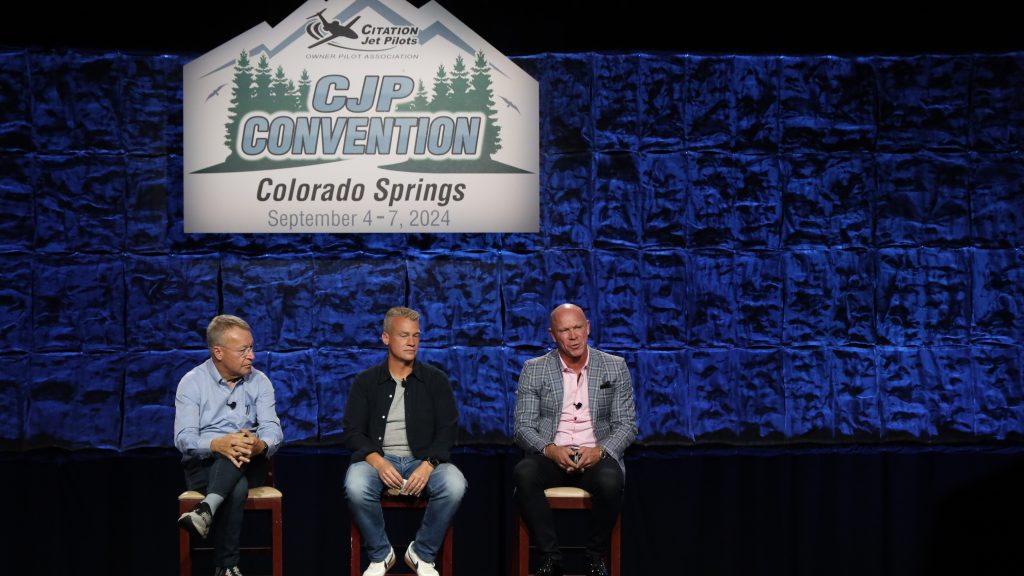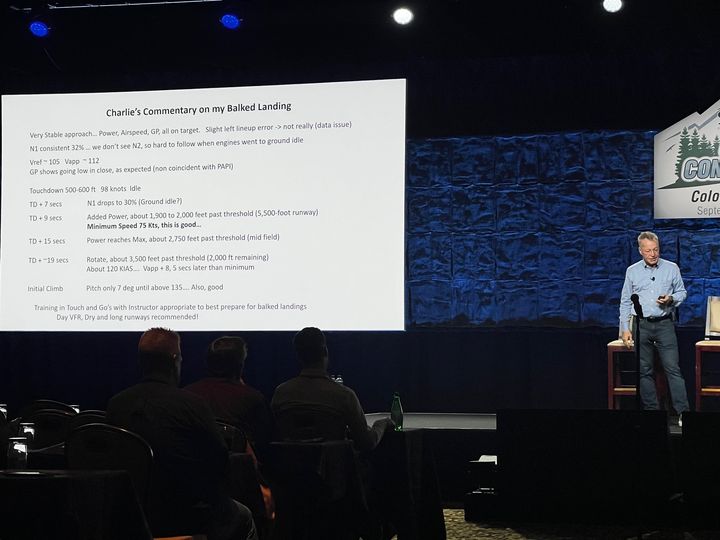“The goal of the next 90 minutes is to give you a live, in-person and interactive ‘never again’ type of experience, from people who fly the same airplanes that you do in the same types of scenarios,” said Brian Currier to kick off this year’s Owner to Owner session, “….And There I Was.”

Currier was joined on stage by Stephen Elop and Endre Holen. All three men recounted an individual “event of note” from their Citation flying experiences, all involving contaminated runways that might have turned into an accident but for their training, and the important lessons they took away from those experiences.
First to share his “never again” was Currier, who recounted a short flight in his C510 Citation Mustang from Smyrna, TN to Rutherford County Airport (FQD) in North Carolina. Mindful of afternoon convective activity, he had planned to depart with his family and their dog onboard in the late morning, but “we arrived after lunch instead of breakfast as originally planned.”
Furthermore, the FBO had topped off the tanks. “So, it’s hot, we’re heavy and I’m now full of fuel,” Currier continued. “And thunderstorms were popping up like crazy.” Those storms persisted as they neared FQD, dumping rain on the airport’s 5,000′ runway.
“We land and I started to hydroplane,” he said. “I’m landing in a downward slope on a contaminated runway with an airplane that’s right near its max landing weight. And I gotta tell you, there were a few things that went through my mind. I’m gonna be [Textron Aviation’s Peter Basile’s] accident case study next year at CJP. And I’m going to ruin Charlie [Precourt’s] CJP safety record. ‘It’s been zero days since our last accident. Thanks, Brian.’”
Fortunately, Currier was able to bring his plane to a stop on the pavement. “Once the braking started and the tires started to grab, the adrenaline came down and we were gonna be okay. But for a moment there, man, it was very uncomfortable.”
To avoid again placing himself and his family in a similar situation, Currier developed new personal standards and minimums. “Any time a variable changes en-route, reexamine the plan,” he added. “En-route thunderstorm poured on that runway? I re-run the numbers. You can run performance calculations right on ForeFlight. It gives you a level of confidence I didn’t have that day.”
Next, Elop described his experience flying his CJ3+ on a “milk run” from Seattle to his family’s vacation home in Sandpoint, ID (SZT) with seven family members onboard, along with full fuel. “The general plan was to get to Sandpoint and not have to refuel there, and have enough fuel to get home again a couple days later,” he said. “So, the planned landing weight was 12,580 pounds, right under max landing weight.”
Ceilings were low and a snow shower had passed over the airport ahead of their arrival. Elop had a wealth of “tools and gadgets” available, including streaming video of the runway from a security camera on the field that showed wispy, blowing snow. He had also called ahead to his diversion airport in Coeur d’Alene (COE) to arrange rental cars in the event conditions deteriorated at SZT.
That said, things looked fine in Sandpoint when they departed for the approximately one-hour flight. “A variable did change [while en-route], though,” he add. “The AWOS reported it had started to lightly snow again [and] ceiling was a bit lower. Okay, so I’ve got to pay attention here as we go into this airport.” Figuring the accumulated snow would be minimal, however, Elop flew the approach and touched down on Runway 2 (5501′ x 75′.)
“Just three or four months before this particular date, I’d done three days of Safe to Land℠ training with MossY,” he continued. It must have been 25 or 30 missed approaches, botched landings, over and over and over and over. It was absolutely exhausting but boy, did it make me comfortable with dealing with the Safe to Land℠ criteria and doing all sorts of different things.
“But here’s the one thing that he always insisted on: when you first touch down on the runway, under all circumstances, test your brakes first,” Elop continued. “Make sure you’ve got brakes before you dump ground flaps. Once those ground flaps are done, you’re done for the day. You are on the ground. But if you test your brakes and you have no brakes, even on a dry runway, you still have the opportunity to go around.”
Elop noted that approach is “a bit controversial” but it came into play on this day. “I made a conscious decision to put the plane down on a recently snow-covered runway where I was ready to give up if the braking action wasn’t my satisfaction,” he said, before showing video derived from FOQA data off his aircraft that showed he did, indeed, perform a botched landing before diverting to COE.

After shutting down, “the family members were sort of like, hold on, we’re at the wrong airport. What happened in Sandpoint?” Elop recounted. “Nothing to worry about. All good. [But] I have warned my wife there will be more go-arounds happening now that I’ve taken Safe to Land℠ training, so she’s comfortable with that.”
Lastly, Holen discussed the impact of icy conditions when he landed his Citation I at Red Wing, MN (RGK) following a short flight from North Dakota the day after Thanksgiving in 2021.
“A big winter storm had been on for several days, and we waited it out,” he said. “Finally, it was getting clear, a nice winter day for the departure home. Blue skies, great conditions.”
Unlike the previous two examples, Holen’s aircraft was also “lightly loaded” for the short flight. “I had checked my runway performance and didn’t think that was a big issue under most scenarios, slush, we were pretty good,” he said. “You know, 3500-3700′ [landing distance.] If it’s icy, it’s a whole different ballgame.
“In the back of my mind, I’m wondering what happens if it starts snowing?” Holen continued. “We’ll probably go to Flying Cloud (FCM) with good services, a control tower, good plowing, all that good stuff.”
Sure enough, Red Wing reported snow showers as they flew closer, “and nobody available on Unicom,” he said. “Flying Cloud weather was good, and they had a good medium braking report by a King Air about 20 minutes before. So, we decided to divert as we weren’t quite sure what we would see at Red Wing.”
While a prudent move, it also set up “the first hole in the Swiss Cheese” for what was to follow. “As we were getting closer, things started kind of getting a little complicated,” Holen explained. “As we lined up on the ILS, ground ops requested to sweep of the runway and tower called them to hold for us. This should have been a sign of maybe thinking twice.”
Nighttime was approaching, and the braking action report was getting older by the minute. “It had been reported by a King Air with reversing props,” he added. “As we broke out at 1000′ [AGL] the runway looked black and clear, with some windblown snow on the side. It was looking a little iffy, so I decided I would set it down early, right on speed and we’re going to hit the brakes right away to test them.”
What happened next, Holen continued, “was not what I anticipated. I touched down, I put the ground flaps in and hit the brakes, and nothing happened. We were just sliding. And I’m like, ‘Okay, I am now a passenger and I’m not sure what’s going to happen.”
As in Currier’s case, the brakes did finally grab with about 1,000′ of pavement to spare and Holen was able to stop on the runway. “I called tower with an updated breaking report, ‘medium to poor,’” he said. “The next thing I heard was a Citation X on the ILS calling a going around. They diverted to MSP [Minneapolis-St. Paul International.]”
In hindsight, Holen said he wouldn’t have assumed the braking report would still be valid, “particularly from airplanes that have reversing props or maybe thrust reversers, and particularly if they’re 20 minutes old. What had happened was the combination of blowing wind and falling temperature created a tiny little ice layer, kind of right as the temperatures were descending. And if ground ops are wanting to sweep wrong way that’s probably another warning sign.
“And certainly, as Stephen mentioned, don’t commit to spoilers or speed brakes until you’ve tested the braking action,” Holen concluded. “My procedure now is to test the brakes right away, and if it doesn’t look good just go around and find a different airport. Being a passenger in your own plane is not fun.”